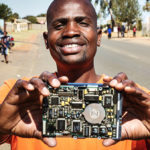This blog was originally posted on the Huffington Post
Research resoundingly reveals that when girls and women are educated, the income they earn is primarily returned to their families, which in turn helps build stronger families and more stable communities. But can something as simple as a dirty bathroom break that positive cycle?
Unfortunately, in some countries it can, especially when adolescent girls reach puberty. UNICEF finds that 1 in 10 school-age African girls “do not attend … or drop out at puberty because of the lack of clean and private sanitation facilities in schools.” Girls’ attendance also drops dramatically if they are not well because of disease or poor nutrition, if the school is far away and parents are concerned for the child’s safety, or if families don’t see the value in spending limited funds on their daughter’s education.
To help more girls become educated, we must first remove these and other barriers that prevent them from attending and staying in school.
Many organizations are doing that — they are building schools in impoverished or politically and socially turbulent regions, establishing schools just for girls and women, and providing qualified female teachers to underserved communities, particularly in developing or underdeveloped countries.
Young women can be particularly hampered by a lack of female teachers since they may not feel as comfortable in classes taught by men. And as more girls see educated women who are prominent in their careers and communities, the more positive role models there are for them to emulate.
We’re making good strides, but there is an even better way to reach more students than through traditional brick-and-mortar institutions: Broadband access to the internet. Broadband makes it easier to extend the classroom’s reach and has dramatically changed how we define schools. In the past, learning often took place in large, formal educational institutions, but today, learning can take place through online courses that are available to anyone, anywhere, any time.
Girls and women are more likely to continue with their education if they feel the curriculum has some relevance to their own lives and is taught in a culturally sensitive way. If they are receiving this education through broadband or online courses, they will become more comfortable using this technology, which is integrated into almost all jobs in today’s economy. That helps assure they will be better equipped to find sustainable jobs and lifelong careers.
Many of the well-established training programs that teach high-demand ICT skills are available online or in a blended learning environment and prepare graduates – men and women alike – for industry-recognized certifications. The Cisco Networking Academy is one such example. Since launching in 1997, the Networking Academy has taught ICT skills to 5 million students in 170 countries. The global average of female participants is 20 percent, but in certain areas, including the Middle East, the average exceeds 35 percent.
Broadband access has become so essential to modern life that a group established by UNESCO and the UN International Telecommunications Union — the Broadband Commission for Digital Development – declared in 2011 that broadband communication “is not just a human need – it is a human right,” similar to food, shelter, and health care. The Commission also stated that “the benefits for broadband are profound,” especially in education, where it can “open young minds to new horizons through educational technology.”
Girls and women represent half of the world’s population. The internet, and all the jobs that come with it, continues to expand, and this makes digital literacy a crucial part of every girls’ education. When girls have the ability to navigate, evaluate and create information using digital technology, they are better equipped to be productive members of the community and economic participants. It is essential that the international community continue to emphasize the importance of educating this half of the population, and building an effective broadband infrastructure will facilitate this process.
This post is based on an excerpt from “Education & Skills 2.0: New Targets & Innovative Approaches,” a book that launched this week at the World Economic Forum in Davos. The authors hope to foster dialogue on key issues in education worldwide. Read it here.


I think, that home education and home business (via Internet) it is a long step into the future.
Only 10-15 years ago, pregnant women, for example, had no opportunity to work. She must she had to stay at home and wait for her husband.
Today, this woman can open her blog about pregnancy, for example and make money with any PPC or partnership programs.
The same can be said about the distance education, when the poor girl from India, for example, can study the same subjects like the girls in modern countries!